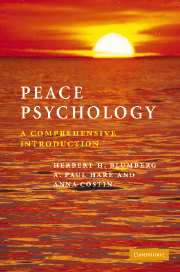Book contents
- Frontmatter
- Contents
- Preface
- Acknowledgements
- The scope, structure and content of this book
- Part I Introduction
- Part II Interdisciplinary practice
- Part III Primary psychological topics
- 6 Developmental issues: children and adolescents
- 7 Theory and practice related to primary psychological topics: attitudes, psychodynamics, cognition and images, and aggression
- 8 Language and communication
- Part IV Core topics in peace and environmental studies
- Part V Terrorism
- References
- Index
6 - Developmental issues: children and adolescents
Published online by Cambridge University Press: 05 June 2012
- Frontmatter
- Contents
- Preface
- Acknowledgements
- The scope, structure and content of this book
- Part I Introduction
- Part II Interdisciplinary practice
- Part III Primary psychological topics
- 6 Developmental issues: children and adolescents
- 7 Theory and practice related to primary psychological topics: attitudes, psychodynamics, cognition and images, and aggression
- 8 Language and communication
- Part IV Core topics in peace and environmental studies
- Part V Terrorism
- References
- Index
Summary
Children are a vulnerable group in society, especially those societies that are experiencing war and conflict. This chapter looks at their understanding of and attitudes towards peace and war and the effects of conflict upon them.
Young people's attitudes and understandings of war and conflict
Even at a very young age – around five or six years – children have developed an understanding of the meanings of war and peace. In a study of Dutch children with a mean age of six years Hakvoort (1996) reported that concrete factors like friendships and the absence of quarrels dominated peace images; weapons, soldiers and the after-effects of war dominated war images. Children at this age did not have an abstract level of reasoning regarding peace. However, as Hakvoort and Oppenheimer (1999) state, the exploration of the developmental pathways for conceptions of war and peace, and strategies for attaining peace, is an area of research that has been theoretically underdeveloped. Hakvoort and Oppenheimer (1998) reviewed studies that address the developing understanding of children's comprehension of peace and war. They found that there is no overall consensus about the meaning of these two concepts. Different cultural settings yield different results. Furthermore there is ample evidence that results are dependent upon the study design and upon variables such as age and gender of the subjects. The authors argue that variables such as social institutions and socialization agents are rarely empirically supported.
- Type
- Chapter
- Information
- Peace PsychologyA Comprehensive Introduction, pp. 55 - 70Publisher: Cambridge University PressPrint publication year: 2006



